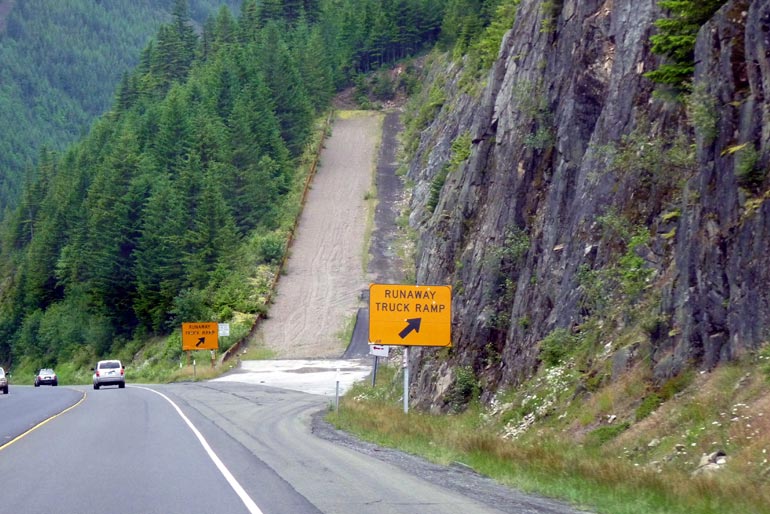As you’re driving through an area with steep hills or mountain passes, you may notice what seems to be an off-ramp leading to a dead-end alongside the road. For the average motorist, these off-ramps to nowhere are nothing more than interesting roadside features. For commercial truck drivers, however, these ramps can mean the difference between life and death in an emergency situation.
The dead-end ramps paralleling the highway are known as “runaway truck ramps.” If truck driver finds themselves unable to operate their vehicle’s brakes, they can use the runaway truck ramp to safely decrease their vehicle’s speed and avoid endangering other motorists. In this article, we discuss the dangers of runaway trucks, how runaway truck ramps work, and the warning signs of an uncontrollable commercial vehicle on the road.
What is a Runaway Truck?
A runaway truck is a commercial vehicle that has lost control of its brakes on a downhill slope. Large trucks are substantially heavier than personal motor vehicles. A truck hooked up to an empty container can weigh 35,000 pounds and a fully-laden vehicle can legally weigh up to 80,000 pounds in the U.S.. Due to the sheer size and weight of a commercial vehicle, there is an increased chance of their brakes failing under the rigorous demand of a steep decline.
To make the situation even more complex, truck drivers must carefully adjust and maintain their vehicle’s speed when navigating uneven or mountainous terrain. Most trucks use diesel fuel, which is not cheap. If a truck loses momentum on an incline, the vehicle burns valuable fuel and the driver may worry that they are thus costing their shipping company revenue. If a driver fails to slow their vehicle down when it reaches the crest of the incline, they may encounter dangerous problems on the decline.
If a driver is late to slow down at the top of the hill, the truck may quickly gain uncontrollable momentum. Especially when a truck is hauling a particularly heavy load, the vehicle’s brakes may be unable to keep the vehicle moving at a safe rate of speed. Even when the truck’s brakes are able to keep the semi-truck itself under control, there is a chance that the trailer may continue moving, jacknife, or even roll over. This poses an incredible risk to everyone on the road, from the truck driver to other unsuspecting motorists. An out-of-control truck can cause a high-speed crash that is likely to result in incredible damage and possibly even serious injuries.
How Does a Runaway Truck Ramp Work?
Fortunately, there are ways to safely stop a runaway truck before anyone is seriously hurt. Most highways that have steep inclines and declines will correspondingly have runaway truck ramps. Runaway truck ramps were initially added to U.S. highways in the mid-20th century and have become commonplace since then.
A runaway truck ramp branches off of the main highway, leading to a dead-end. They are typically marked by a yellow sign so that the ramp is visible to drivers dealing with an emergency situation. Many ramps use sand or gravel to increase friction between the road and the truck’s tires, thus bringing the vehicle to a stop as quickly as possible. Other designs use wire nets with breakaways to bring the truck under control. In most cases, the ramp will slope upwards, so that a runaway vehicle’s momentum decreases even more quickly.
Warnings Signs of a Runaway Truck on the Road
Having identified what a truck ramp is and does, it’s important to be able to recognize the signs of an out-of-control commercial vehicle. Knowing what a runaway truck looks like on the road may save your life, as well as those of your passengers. Whenever you approach or pass a truck, you should be paying close attention to any signs of trucker distress, including:
- Excessive braking: If a truck driver repeatedly hits the brakes despite there being no obstacles or cars ahead of them, they may be tired, distracted, or attempting to regain control over their vehicle. Keep a safe distance.
- Screeching brakes: If a truck’s brakes screech as it comes to a stop, that may indicate that they are in poor shape. Old or dangerous brakes may also be a warning sign that the rest of the truck has not been well-maintained either.
- Wobbly tires: When a truck’s tires appear to wobble or shake, this may be a sign that they have seen excessive use. Shaking tires may foreshadow a dangerous blowout.
- Open trailer: Should you observe that a truck’s trailer is open, you should beware of falling crates, shipments, or other debris. Do not follow directly behind the open trailer and be aware that debris may cross multiple lanes and provide a hazard for anyone following the truck.
- Fishtailing or swerving: If you observe that a truck’s trailer seems to be drifting into other lanes or travel or the vehicle is swerving back and forth, this can indicate that the driver has lost control of their rig.
Steps to Follow After a Truck Accident
The incredible force exerted in a runaway truck crash makes such collisions incredibly stressful and terrifying for accident victims. If you are involved in or witness a crash involving a runaway truck, try your best to stay calm and:
- Call 911 immediately
- Get to a safe location, away from traffic or additional hazards
- Seek medical attention for yourself or any other victims
- Document the scene of the accident
- Take down the contact information of any witnesses
- Speak to a local truck accident attorney







